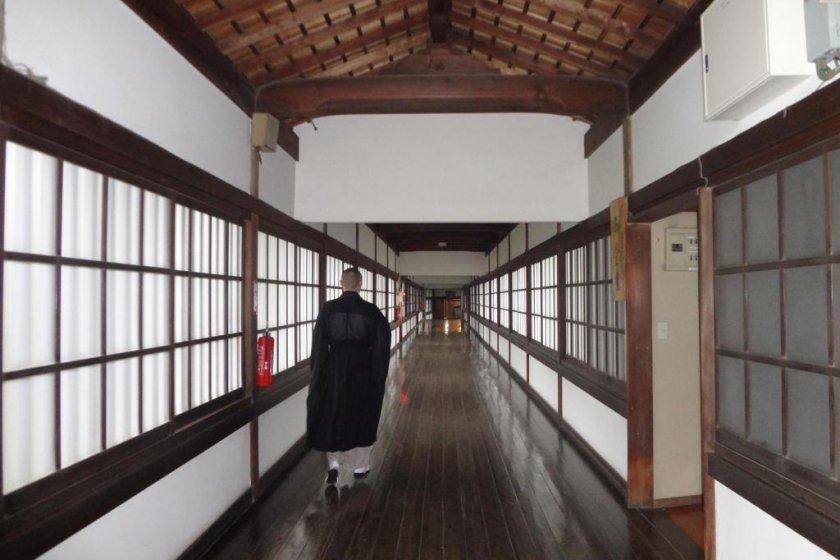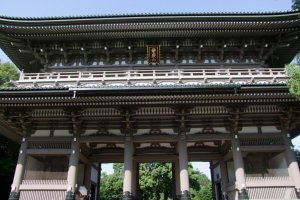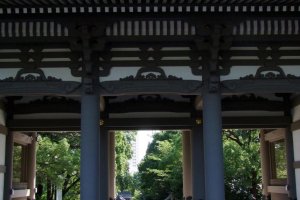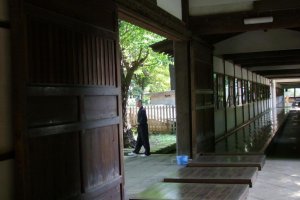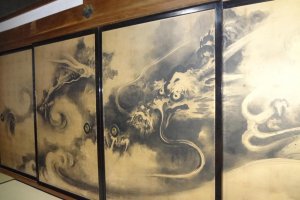At 4 am, a young monk runs through the corridors of the temple, ringing a loud wake-up bell. A new day has begun. Fifteen minutes later, 160 monks, seated in lines on meditation platforms, begin their morning zazen. Since the temple first opened (100 years ago here, and 700 years ago at the main temple in Fukui Prefecture) the same monastic Zen life has been continued to the present day.
Soji-ji is one of the two biggest Zen temples of the Soto sect. In the middle of the Kamakura era (1185-1333), its founder, Dogen, after studying Buddhism in China, returned to Japan, and established Eihei-ji in Fukui. His disciples later established Soji-ji (also in Fukui) where their simple yet deep Zen practices flourished. But one day, a fire destroyed almost all of the buildings of Soji-ji. So, they decided to rebuild in Yokohama to help spread the sect’s teachings.
Soji-ji is about a 7-minute walk from JR Tsurumi station on the Keihin Tohoku Line. It's quite unusual for such a big temple to be so close to the city. (For example, the previously mentioned Eihei-ji is situated deep in the mountains, hours from any big town.) The Soji-ji temple grounds holds twelve large buildings and a cemetery, totaling almost 50,000 square meters. When you walk up the slope from the street and then come in through the gate (三門Sanmon), you've already stepped into a Zen world. You are free to walk around these beautiful grounds and explore. There are benches, and temple buildings spread out over the area. However, if you would like to experience looking around inside a temple building, then follow the directions below.
After coming in the first gate (a stone entrance way from the street) and walking straight up the drive for a few minutes, you will eventually come to building No. 2 on this map, the beautiful wooden gate mentioned above. Turn right here. Your goal is building No. 4: Kou-shaku-dai (香積台). There are shoe lockers and a reception room here. If you come in late March or early April, cherry trees in full bloom will welcome you. This temple doesn't charge an entrance fee if you just want to look around by yourself. So, please feel free to go into the building. It contains beautiful, dark wooden corridors, large tatami rooms, access to a Japanese style garden, and so on. I'm sure you will admire the monks and their lifestyle in the temple. And I am sure that you know not to disrupt things, by making noise, speaking loudly, touching treasures or statues, or taking pictures of the monk's faces. Those things are considered to be rude and inconsiderate.
Although you are free to look around at your own pace, you might understand and feel the Zen mind more, if you join a tour given by the monks (400 yen; by appointment only). The guide priest will lead you and explain about the temple and its daily life. At present, 140 monks and 20 mentors are living at this monastery. After they have their morning meditation, sutra chanting and prostrations begin at Daisodo (大祖堂) at 5 o'clock. Then at 6:30, they have a really simple breakfast, consisting of one cup of rice gruel, only a little bit of sesame, and pickles. They offer a chant and prayer, and then eat with appreciation, followed by a proclamation of a series of Zen rules. After that, at about 7:30, they clean the monastery, gardens, and everywhere else with full devotion. Please take a look at the long corridor called Hyak-ken-rou-ka (百間廊下). It is 152m long and symbolizes the border between a holy place and the regular world. Monks have cleaned the corridor floors 2 times a day, 365 days a year, since the temple was built. Please touch the floor. You will see it is well polished. They never use wax and cleanser, but it is completely clean and bright!
At the end of your stay, I strongly recommend that you see the Stove God near the waiting room of Kou-shaku-dai. The God is a 180cm high wooden statue and it is the biggest wooden God in Japan. There is a kitchen under the God. Monks chant to the God every morning. This wooden God is a symbol of wealth, and they believe that if you pray sincerely to this God, you will forever be safe from starvation.
I think you will have many chances to visit temples in Kyoto, Nara and other places in Japan. But Soji-ji is special. In spite of a serious and severe Zen life, the monks always open their doors to everyone.
*Read an article on Kanagawa's other famous Zen Temple, Kencho-ji.
